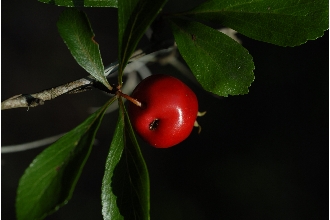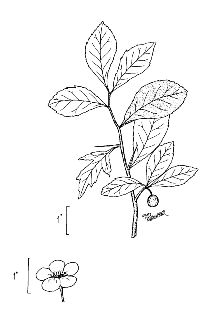May Hawthorn
Scientific Name: Crataegus aestivalis (Walter) Torr. & A. Gray

| General Information | |
|---|---|
| Usda Symbol | CRAE |
| Group | Dicot |
| Life Cycle | Perennial |
| Growth Habits | ShrubTree, |
| Native Locations | CRAE |
Plant Guide
Uses
Erosion Control: Because it tolerates a wide variety of sites, it can be planted to stabilize banks, for shelterbelts, and from wind and water erosion. Timber: Although the wood is hard and strong, it has no commercial value except for tool handles and other small items. Fruits are often gathered for jellies. Wildlife: It provides excellent cover and nesting sites for many smaller birds. Birds, rodents, and other smaller mammals eat the small fruits. White tailed deer browse the young twigs and leaves. Beautification/landscape: It is used in beautification project around homes, city streets, and office buildings. It is excellent for environmental plantings, including small specimen tree and shrub borders.
Status
Please consult the PLANTS Web site and your State Department of Natural Resources for this plant’s current status, such as, state noxious status and wetland indicator values. R. Mohlenbrock USDA, NRCS, Wetland Sciences Institute @ PLANTS
Description
General: It is a spiny tree that grows to forty feet high and fifteen inches DBH. Leaves are narrow, broadest above or near the middle, dark green and shiny, serrated, seldom lobed and smooth. Flowers are white, produced singly or in two or three flowered clusters. Fruits are broadest above the middle or rounded, and red in color. Distribution: May hawthorn grows on the outer coastal plain from North Carolina to Mississippi. For current distribution, please consult the plant profile page for this species on the PLANTS Web site.
Adaptation
Although it will succeed in partial shade and different soil types, it grows best in full sunlight, well-drained loamy soils. May hawthorn will tolerate wet soils becoming drought tolerant once established. It is wind tolerant making it a good tree species in shelterbelt planting. It is also tolerant of atmospheric pollution and performs well in urban settings. It is commonly found in river swamps, pond areas, and stream banks.
Establishment
Propagation from Seed or Grafting: May hawthorn can be propagated by either seeds or grafting. Successful propagation using seeds requires acid scarification followed by warm stratification and prechilling. Seeds, whose numbers per pound (lb.) varies with species, are planted early in the fall, in drill rows eight to twelve inches apart and covered with 1/4 inch of soil. Seedlings must not be kept in the nursery longer than a year. Containerized trees should be planted when they are no more than eight feet tall, in the fall or early spring. Balled and burlapped trees should be planted in early spring. Grafting on seedling stock of Crataegus oxyacantha or Crataegus monogyna is best carried out in the winter to early spring.
Management
Pruning should be done in the winter or early spring in order to maintain a clear shoot leader on young trees and/or remove the weakest branches to allow more light to pass through. Suckers or stems arising from the roots should be removed when they become noticeable.
Pest and Potential Problems
Although pests and diseases seldom affect Crataegus aestivalis, it is susceptible to fire-blight, cedar-hawthorn rust, cedar-quince rust, leaf blight and fruit rot, and leaf spot. Cultivars, Improved and Selected Materials (and area of origin) Consult your local nurseries to choose the right cultivar for your specific landscape. Contact your local Natural Resources
Conservation
Service (formerly Soil Conservation Service) office for more information. Look in the phone book under ”United States Government.” The Natural Resources Conservation Service will be listed under the subheading “Department of Agriculture.”
References
Dirr, M,A, 1990, Manual of woody landscape plants: their identification, ornamental characteristics, culture, propagation and uses, 3rd ed, Stipes, Champaign, Illinois, Duncan, W,H, & M,B, Duncan 1988, Trees of the Southeastern United States, University of Georgia Press, Athens, Georgia, Elias, T,S, 1989, Field guide to North American trees, Revised ed, Grolier Book Clubs Inc,, Danbury, Connecticut, Flint, H,L, 1983, Landscape plants for eastern North America, John Wiley and Sons, Inc, New York, New York, Harrar, E,S, & J,G, Harrar, 1962, Guide to southern trees, 2nd ed, Dover Publications, Inc,, New York, New York, Little, E,E, 1996, National Audubon Society field guide to North American trees: Eastern region, Alfred A, Knopf, New York, New York, USDA Forest Service 1974, Seeds of woody plants in the United States, Use soil moisture sensors to measure the soil moisture of May Hawthorn., Agricultural Handbook 450, USDA, Washington, DC, USDA Forest Service 1990, Silvics of North America, Agricultural Handbook 654, Forest Service, USDA, Washington, DC, Young, J, A, & C,G, Young, 1992, Seeds of woody plants in North America, Revised and enlarged ed, Dioscorides Press, Portland, Oregon
Fact Sheet
Alternative Names
Eastern May Hawthorn, Apple May Hawthorn, Summer Haw and Mayhaw
Uses
Food: The fruit is frequently used for preserves and jellies and can also be dried for later use. Erosion control: Can be used in shelter belts and stream- bank stabilization. Wildlife: Provides nesting sites and cover for small birds. Birds and small mammals eat the fruit. Whitetail deer browse the leaves and young stems. Timber: The wood is heavy and strong but is too small for commercial use. Eastern May Hawthorn wood is used locally for tool handles and mallets. Medicinal: It has been used as a tea in herbal folk medicine for treatment of high blood pressure. Landscaping: In recent years this plant has become popular with home and commercial landscapers due to the plant’s showy white flowers, attractive foliage and ability to adapt to a variety of sites.
Status
Please consult the PLANTS Web site and your State Department of Natural Resources for this plant’s current status (e.g., threatened or endangered species, state noxious status, and wetland indicator values).
Description and Adaptation
Adaptation
Adaptation
Description: A member of the Rosaceae family, the May Hawthorn is a deciduous, small, round- topped tree growing to 30 feet in height. Leaves are dark green, simple, and are alternately arranged.. Flowers are white and produced either singly or in clusters of 2 or 3.The fruit is a fleshy, red pome borne in May, contributing to the common name “Mayhaw”. Twigs are brown to gray and spiny. May Hawthorn distribution from USDA-NRCS PLANTS Database. Adaptation: While preferring full sun, Eastern May Hawthorn will tolerate partial shade. Once established it will also tolerate wet soils and drought conditions. It will grow in a variety of soil types, but preferring well drained, slightly acid soils. Their tolerances to air pollution make it a good choice for urban sites. For updated distribution, please consult the Plant Profile page for this species on the PLANTS Web site.
Establishment
Under natural conditions Eastern May Hawthorn seeds do not germinate until overwintered. Successful seed germination requires acid stratification followed by warm stratification and chilling. Propagation can also be done using softwood stem cuttings rooted under an intermittent mist. The use of a rooting hormone will increase rooting success. Propagation from hardwood and root cuttings is also possible. Grafting to English Hawthorn (Crataegus oxyacantha or Single Seeded Hawthorn (Crataegus monogyna rootstock is possible but should be done in winter or early spring.
Management
Annual pruning in the winter to open up the tree canopy will be beneficial in increasing fruit production, Use soil moisture sensors to measure the soil moisture of May Hawthorn., In addition weak branches and sucker stems should be removed at this time,
Pests and Potential Problems
May Hawthorn is susceptible to some of the same insects and diseases that attack other pome fruits. These include insects such as the hawthorn lace bug and roundheaded appletree borer along with leafminers and mealy bugs. Diseases affecting May Hawthorn include fire-blight, cedar-hawthorn blight, cedar quince blight and fruit rot. Cultivars, Improved, and Selected Materials (and area of origin) Commercially available Crataegus aestivalis include: Lori -80% harvest at one time and Linsey also with concentrated ripening.
Prepared By
Michael Woody Biological Science Technician, East Texas Plant Materials Center, Nacogodoches Texas
Plant Traits
Growth Requirements
| Temperature, Minimum (°F) | -8 |
|---|---|
| Adapted to Coarse Textured Soils | No |
| Adapted to Fine Textured Soils | No |
| Adapted to Medium Textured Soils | Yes |
| Anaerobic Tolerance | Medium |
| CaCO3 Tolerance | Low |
| Cold Stratification Required | Yes |
| Drought Tolerance | Low |
| Fertility Requirement | Medium |
| Fire Tolerance | Low |
| Frost Free Days, Minimum | 180 |
| Hedge Tolerance | Medium |
| Moisture Use | High |
| pH, Maximum | 7.3 |
| pH, Minimum | 4.3 |
| Planting Density per Acre, Maxim | 700 |
| Planting Density per Acre, Minim | 300 |
| Precipitation, Maximum | 60 |
| Precipitation, Minimum | 34 |
| Root Depth, Minimum (inches) | 18 |
| Salinity Tolerance | None |
| Shade Tolerance | Intolerant |
Morphology/Physiology
| Bloat | None |
|---|---|
| Toxicity | None |
| Resprout Ability | Yes |
| Shape and Orientation | Erect |
| Active Growth Period | Spring and Summer |
| C:N Ratio | Medium |
| Coppice Potential | Yes |
| Fall Conspicuous | No |
| Fire Resistant | No |
| Flower Color | White |
| Flower Conspicuous | Yes |
| Foliage Color | Dark Green |
| Foliage Porosity Summer | Moderate |
| Foliage Porosity Winter | Porous |
| Foliage Texture | Fine |
| Fruit/Seed Conspicuous | Yes |
| Nitrogen Fixation | None |
| Low Growing Grass | No |
| Lifespan | Moderate |
| Leaf Retention | No |
| Known Allelopath | No |
| Height, Mature (feet) | 26.0 |
| Height at 20 Years, Maximum (fee | 26 |
| Growth Rate | Slow |
| Growth Form | Multiple Stem |
| Fruit/Seed Color | Red |
Reproduction
| Vegetative Spread Rate | None |
|---|---|
| Small Grain | No |
| Seedling Vigor | Medium |
| Seed Spread Rate | Moderate |
| Fruit/Seed Period End | Summer |
| Seed per Pound | 20000 |
| Propagated by Tubers | No |
| Propagated by Sprigs | No |
| Propagated by Sod | No |
| Propagated by Seed | Yes |
| Propagated by Corm | No |
| Propagated by Container | Yes |
| Propagated by Bulb | No |
| Propagated by Bare Root | Yes |
| Fruit/Seed Persistence | Yes |
| Fruit/Seed Period Begin | Spring |
| Fruit/Seed Abundance | Medium |
| Commercial Availability | Routinely Available |
| Bloom Period | Mid Spring |
| Propagated by Cuttings | No |
Suitability/Use
| Veneer Product | No |
|---|---|
| Pulpwood Product | No |
| Protein Potential | Medium |
| Post Product | No |
| Palatable Human | No |
| Palatable Graze Animal | Low |
| Palatable Browse Animal | High |
| Nursery Stock Product | Yes |
| Naval Store Product | No |
| Lumber Product | No |
| Fodder Product | No |
| Christmas Tree Product | No |
| Berry/Nut/Seed Product | No |





